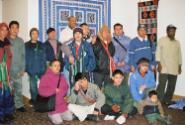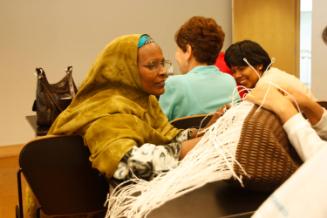Exhibit Event - Weaving a New Life: The Refugee Artists Sewing Circle
SubjectPortrait of
Fatima Vejzovic
(Bosnian)
SubjectPortrait of
Yvonne Ntakiratimana
(Burundian)
SubjectPortrait of
Pwe Say Paw
(Burmese Karen)
SubjectPortrait of
Nu Wah
(Burmese Karen)
Date2009 January-February
Mediumborn digital photography
ClassificationsGraphics
Credit LineConnecticut Cultural Heritage Arts Program collections
CopyrightIn Copyright
Object number2015.196.441.25-.39
DescriptionPhotographs from the Clare Gallery exhibition, "Weaving a New Life: The Refugee Artists Sewing Circle," in 2009.
(.25) Image of Bosnian weaver Fatima Vejzovic demonstrating weaving.
(.26) Image of a Burmese Karen exhibit artist standing in front of the Hmong costume on display made by May Xiong.
(.27) Image of Yvonne Ntakiratimana standing in front of her crochet work on display.
(.28-.30) Images of a group portrait of the English as a Second Language (ESL) class students from the Hartford Public Library visiting the exhibit.
(.31) Image of a Hmong wall hanging sewn and embroidered by Mai Xiong.
(.32-.35) Images of a group portrait of the English as a Second Language (ESL) class students from the Hartford Public Library visiting the exhibit.
(.36) Image of a Burmese Karen exhibit artist (left) and a woman from Bukhara (right) standing in front of the Hmong costume on display.
(.37) Image of Burmese Karen exhibit artist Pwe Say Paw with her woven shirt on display.
(.38) Image of Burmese Karen exhibit artist Nu Wah with her woven shirt on display.
(.39) Image of a group portrait of the English as a Second Language (ESL) class students from the Hartford Public Library visiting the exhibit.
NotesSubject Note: CCHAP collaborated with The Clare Gallery to present "Weaving a New Life: The Refugee Artists Sewing Circle," a multi-media exhibition from January 22 to February 22, 2009 featuring textile arts created by recent refugees and more longstanding immigrants to the Greater Hartford area. A reception was held on February 17, with participating artists demonstrating their weaving and needlework techniques. The Sewing Circle began in 2007 as an exciting initiative to encourage production and marketing of traditional crafts among the many immigrant communities in the Greater Hartford area and across the state, initiated by the Institute for Community Research’s Connecticut Cultural Heritage Arts Program based in Hartford. Lynne Williamson, Director of CCHAP at ICR, introduced the artists and described the history of the project, the diverse artwork and traditions of the artists, and the project’s importance to the Hartford community. (.25) Image of Bosnian weaver Fatima Vejzovic demonstrating weaving.
(.26) Image of a Burmese Karen exhibit artist standing in front of the Hmong costume on display made by May Xiong.
(.27) Image of Yvonne Ntakiratimana standing in front of her crochet work on display.
(.28-.30) Images of a group portrait of the English as a Second Language (ESL) class students from the Hartford Public Library visiting the exhibit.
(.31) Image of a Hmong wall hanging sewn and embroidered by Mai Xiong.
(.32-.35) Images of a group portrait of the English as a Second Language (ESL) class students from the Hartford Public Library visiting the exhibit.
(.36) Image of a Burmese Karen exhibit artist (left) and a woman from Bukhara (right) standing in front of the Hmong costume on display.
(.37) Image of Burmese Karen exhibit artist Pwe Say Paw with her woven shirt on display.
(.38) Image of Burmese Karen exhibit artist Nu Wah with her woven shirt on display.
(.39) Image of a group portrait of the English as a Second Language (ESL) class students from the Hartford Public Library visiting the exhibit.
"Weaving a New Life: The Refugee Artists Sewing Circle" highlights a collection of global crafts made by artists including Fatuma Ahmed, a Somali basket weaver; Fatima Vejzovic, a Bosnian rug weaver; Melka and Mevlija, Bosnian crochet and knit workers; Florence Betgeorge, an Assyrian lace maker; Mai Xiong and Mai Lee, Hmong embroiderers; Elena Cupceancu, a Romanian needleworker; Kannah Zealey, a Liberian tailor; Yvonne Ntakiratimana, a Burundi crochet and embroidery expert; Somali weaver Fatuma Ahmed; Burmese Karen weavers Pwe Say Paw and Nu Wah, and several other textile artists. Though most of the artists have experienced war, trauma, and dislocation, they continue to practice their cultural heritage and traditions, blending these with current experiences to create artwork that is both beautiful and functional. Many immigrants and refugees have come to live in the Hartford area. CCHAP, working with local refugee groups and service providers, identified the need for an initiative that would develop and market the remarkable skills of these newcomers. The Sewing Circle Project members met regularly to work on their art forms and share coffee and conversation. This supportive environment provided social interaction among the artists, recognition of their cultural heritage and artistic traditions, stimulated literacy improvement, and helped to locate marketplaces for their artwork. Sewing Circle participants have sold their work in Hartford at the Hartford Library World Refugee Day; Open Studio Weekends; the International ICR Conference; and as regular vendors at the Billings Forge Farmers Market on summer Thursdays. The project also offered small business training to the artists, through grants from the Aurora Foundation, the Aetna Foundation, and the Avon Hello Tomorrow Fund.
The Clare Gallery primarily features exhibitions that emphasize world religions or interfaith themes, as well as social justice themes, on either a global or local level. The Gallery is housed in the Franciscan Center for Urban Ministry at 285 Church Street in Hartford, Connecticut. The Center is part of St. Patrick – St. Anthony Church, a vibrant and active downtown faith community.
Subject Note: The Karen are a group of tribal people living in the hills of northern Burma and northern Thailand. Forced out of Burma by repressive military governments since 1975, Karen refugees relocated to camps in Thailand. Over 200 Karen have settled in Hartford in recent years, bringing with them excellent musical and textile skills. Many Karen can weave their own cloth, making traditional shirts, sarongs, and shoulder bags. Although the preferred materials for looms and cloth can be difficult to find, family members build looms for the weavers using PVC pipes instead of bamboo. Mu Wah learned all the techniques of weaving from her mother starting at the age of ten. She and weaver Hser Nay Paw came to Hartford in 2007, joining the Sewing Circle Project as a way to continue their cultural heritage. Myint Khin arrived in Connecticut in early September 2013, to reunite with her family. She learned to weave from teachers in the Thailand camp, and has now taught her four daughters.
Karen women and men weave their fine cotton cloth on backstrap looms that can be rolled up and transported from place to place. First the threads are stretched out in a continuous loop around an upright frame with wooden or bamboo posts that hold the yarn tight. Then this set of threads still on the posts is lifted off the frame and turned horizontally to form the warp that is now stretched out as the basis of the cloth. The weaver ties one of the posts to a stationary object such as a tree, with the other post in front of her and tied at either end to a strap around her back. Leaning back to create tension on the warp threads, she can weave back and forth between the threads to create cloth. Intricate patterns with dyed threads are woven into the base cloth, and weavers will sometimes embellish the cloth with embroidery and beads made of seeds. Specific patterns can tell stories or reflect inspirations and knowledge from nature, in a kind of visual narrative. Different colors and stripe patterns can denote marital status or occupations of the person wearing the cloth.
Hartford is now home to several Karen weavers – Hser Nay Paw, Mu Wah, Nu Wah, Pwe Say Paw, and Myint Khin are some of the Burmese Karen weavers who use traditional backstrap looms to make the clothing worn by all members of their large community in Hartford. Their woven cloth, bags, shirts, and scarves have been exhibited by CCHAP in several exhibits including Weaving a New Life: The Refugee Artists Sewing Circle at the Clare Gallery in Hartford in 2009, and in the 2013-2015 traveling exhibit New Lives New England, displayed at the Vermont Folklife Center in Middlebury VT, and the Institute for Community Research in Hartford. Myint Khin and Mu Wah traveled with CCHAP to demonstrate weaving at the Vermont Folklife Center in December 2013.
Mu Wah learned all the techniques of weaving from her mother starting at the age of ten. She and weaver Hser Nay Paw came to Hartford in 2007, joining the Sewing Circle Project as a way to continue their cultural traditions. Myint Khin is a Burmese Karen master weaver who arrived in early September 2013 to live with family members already settled in Hartford. She learned to weave from teachers in the Thailand refugee camp, and has now taught her daughters. She has presented programs in Greater Hartford schools, with students from Miss Porters School, and at Trinity College to show students her back strap weaving and the clothes she makes. Myint was a popular weaver in the refugee camp in Thailand where her four daughters were born, three of them are also weavers. Myint is in demand as a weaver and seamstress for the Burmese Karen community in Connecticut and New England.
Additional audio, video, and photographic materials exist in the archive relating to these communities and artists.
Cataloging Note: This project was made possible in part by the Institute of Museum and Library Services MA-245929-OMS-20.
Status
Not on viewJampa Tsondue
2018 March 10
Haris Gusta Guya
2011 November 4




























